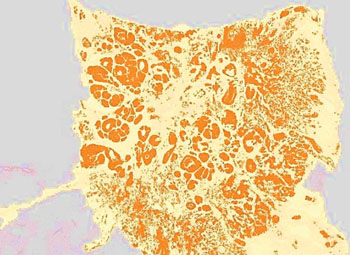Biomarker Reveals Cause of Papillary Thyroid Carcinoma
By LabMedica International staff writers
Posted on 27 Oct 2014
The expression of the CAP-GLY domain containing linker protein 2 (CLIP2) provides information on whether a papillary thyroid carcinoma was induced by radiation or had a sporadic origin.Posted on 27 Oct 2014
The biomarker CLIP2 serves as a radiation marker because after exposure to radiation from radioiodine, both the genetic activity and the protein expression are increased especially among children exposed to the radioiodine fallout and have developed papillary thyroid carcinoma (PTC).

Image: Tumor cell populations identified using digital image analysis from a stained pathology slide, with the tumor regions detected and now colored orange (Photo courtesy of Definiens).
Scientists at the Helmholtz Zentrum München (Neuherberg, Germany), and their international colleagues, studied PTCs from a cohort of young patients exposed to the post-Chernobyl radioiodine fallout at very young age and a matched non-exposed control group. They investigated the potential role of CLIP2 as a radiation marker to be used for the individual classification of PTCs into CLIP2-positive and -negative cases, a prerequisite for the integration of CLIP2 into epidemiological modelling of the risk of radiation-induced PTC. A discovery cohort of 33 individuals and two independent validation cohorts of 115 PTCs were investigated.
The team were able to validate the radiation-associated CLIP2 overexpression at the protein level by immunohistochemistry (IHC) followed by relative quantification using digital image analysis software (Definiens AG; Munich, Germany). They analyzed the function of CLIP2 in radiation-associated PTC, by reconstructing the CLIP2 gene regulatory network using global messenger ribonucleic acid (mRNA) expression data from PTC patient samples. The genes comprising the first neighborhood of CLIP2, BCL2-associated athanogene 2 (BAG2), carbohydrate (chondroitin 6) sulfotransferase 3 (CHST3), kinesin family member 3C (KIF3C), neuralized E3 ubiquitin protein ligase 1 (NEURL1), peptidylprolyl isomerase (cyclophilin)-like 3 (PPIL3), and regulator of G-protein signaling 4 (RGS4) suggest the involvement of CLIP2 in the fundamental carcinogenic processes including apoptosis, mitogen-activated protein kinase signaling and genomic instability.
Julia Hess, MD, the senior author of the study said, “CLIP2 serves as a radiation marker and allows us to distinguish between radiation-induced and sporadic thyroid carcinomas. This biomarker allows us both to draw conclusions about the mechanisms involved in the development of such tumors and to evaluate the risk of thyroid cancer after exposure to high level radiation, for instance, following a radiation accident.” The study was published on October 6, 2014, in the journal Oncogene.
Related Links:
Helmholtz Zentrum München
Definiens AG













